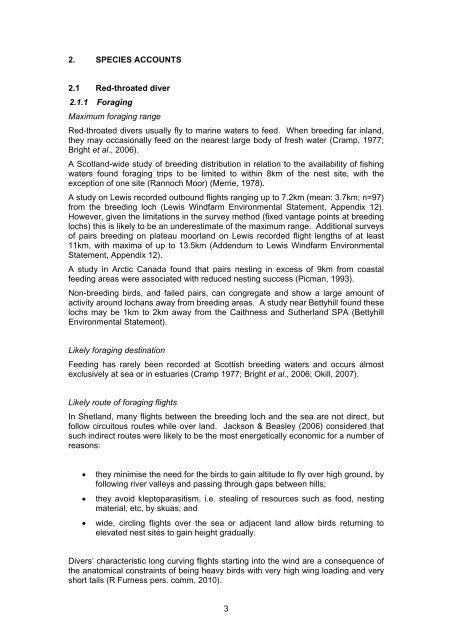Literature review to assess bird species connectivity to Special ...
Literature review to assess bird species connectivity to Special ...
Literature review to assess bird species connectivity to Special ...
Create successful ePaper yourself
Turn your PDF publications into a flip-book with our unique Google optimized e-Paper software.
2. SPECIES ACCOUNTS<br />
2.1 Red-throated diver<br />
2.1.1 Foraging<br />
Maximum foraging range<br />
Red-throated divers usually fly <strong>to</strong> marine waters <strong>to</strong> feed. When breeding far inland,<br />
they may occasionally feed on the nearest large body of fresh water (Cramp, 1977;<br />
Bright et al., 2006).<br />
A Scotland-wide study of breeding distribution in relation <strong>to</strong> the availability of fishing<br />
waters found foraging trips <strong>to</strong> be limited <strong>to</strong> within 8km of the nest site, with the<br />
exception of one site (Rannoch Moor) (Merrie, 1978).<br />
A study on Lewis recorded outbound flights ranging up <strong>to</strong> 7.2km (mean: 3.7km; n=97)<br />
from the breeding loch (Lewis Windfarm Environmental Statement, Appendix 12).<br />
However, given the limitations in the survey method (fixed vantage points at breeding<br />
lochs) this is likely <strong>to</strong> be an underestimate of the maximum range. Additional surveys<br />
of pairs breeding on plateau moorland on Lewis recorded flight lengths of at least<br />
11km, with maxima of up <strong>to</strong> 13.5km (Addendum <strong>to</strong> Lewis Windfarm Environmental<br />
Statement, Appendix 12).<br />
A study in Arctic Canada found that pairs nesting in excess of 9km from coastal<br />
feeding areas were associated with reduced nesting success (Picman, 1993).<br />
Non-breeding <strong>bird</strong>s, and failed pairs, can congregate and show a large amount of<br />
activity around lochans away from breeding areas. A study near Bettyhill found these<br />
lochs may be 1km <strong>to</strong> 2km away from the Caithness and Sutherland SPA (Bettyhill<br />
Environmental Statement).<br />
Likely foraging destination<br />
Feeding has rarely been recorded at Scottish breeding waters and occurs almost<br />
exclusively at sea or in estuaries (Cramp 1977; Bright et al., 2006; Okill, 2007).<br />
Likely route of foraging flights<br />
In Shetland, many flights between the breeding loch and the sea are not direct, but<br />
follow circui<strong>to</strong>us routes while over land. Jackson & Beasley (2006) considered that<br />
such indirect routes were likely <strong>to</strong> be the most energetically economic for a number of<br />
reasons:<br />
<br />
<br />
they minimise the need for the <strong>bird</strong>s <strong>to</strong> gain altitude <strong>to</strong> fly over high ground, by<br />
following river valleys and passing through gaps between hills;<br />
they avoid klep<strong>to</strong>parasitism, i.e. stealing of resources such as food, nesting<br />
material, etc, by skuas; and<br />
wide, circling flights over the sea or adjacent land allow <strong>bird</strong>s returning <strong>to</strong><br />
elevated nest sites <strong>to</strong> gain height gradually.<br />
Divers’ characteristic long curving flights starting in<strong>to</strong> the wind are a consequence of<br />
the ana<strong>to</strong>mical constraints of being heavy <strong>bird</strong>s with very high wing loading and very<br />
short tails (R Furness pers. comm. 2010).<br />
3

















